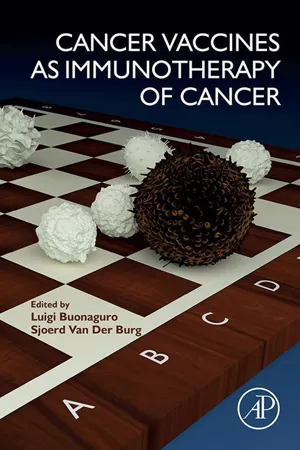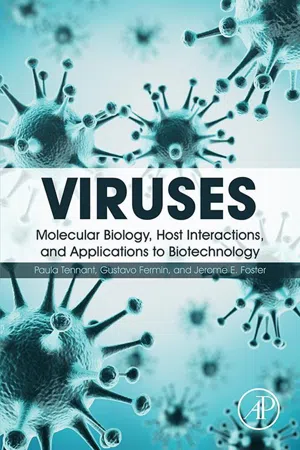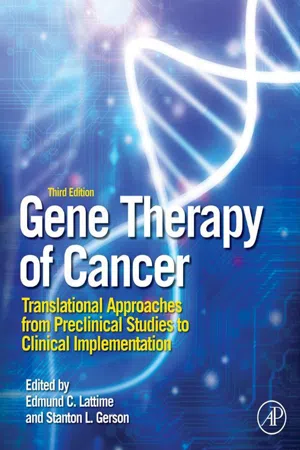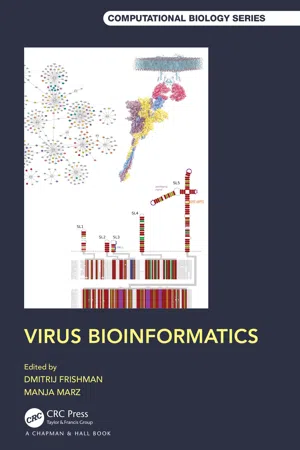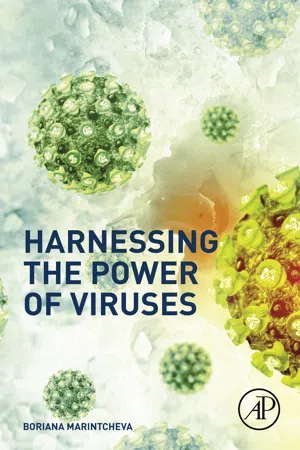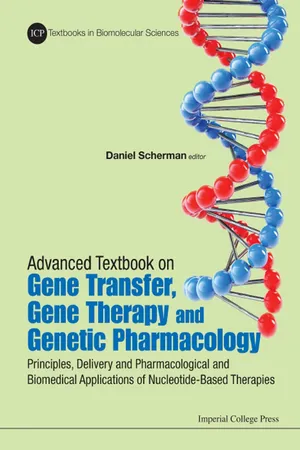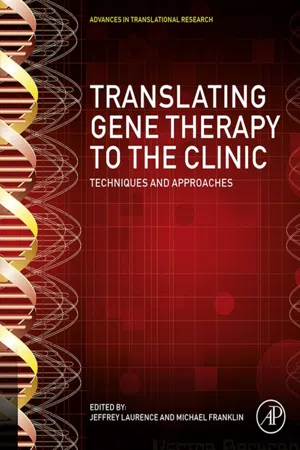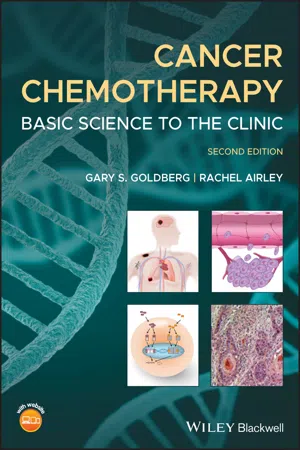Biological Sciences
Oncolytic Viruses
Oncolytic viruses are a type of virus that can selectively infect and kill cancer cells while sparing normal cells. They are being studied as a potential treatment for cancer, either alone or in combination with other therapies. Oncolytic viruses work by replicating within cancer cells, causing them to burst and die, and also by stimulating the immune system to target the cancer.
Written by Perlego with AI-assistance
Related key terms
9 Key excerpts on "Oncolytic Viruses"
- eBook - ePub
- Luigi Buonaguro, Sjoerd Van Der Burg(Authors)
- 2022(Publication Date)
- Academic Press(Publisher)
Chapter 1Oncolytic Viruses for antigen delivery
Erkko Ylösmäki1 ,2, Vincenzo Cerullo1 ,2 ,3 ,4, John C. Bell5 and Marie-Claude Bourgeois-Daigneault6 ,7 ,8,1 Laboratory of Immunovirotherapy, Drug Research Program, Faculty of Pharmacy, University of Helsinki, Helsinki, Finland,2 TRIMM, Translational Immunology Research Program, University of Helsinki, Helsinki, Finland,3 iCAN Digital Precision Cancer Medicine Flagship, University of Helsinki, Helsinki, Finland,4 Department of Molecular Medicine and Medical Biotechnology and CEINGE, Naples University Federico II, Naples, Italy,5 Cancer Therapeutics Program, Ottawa Hospital Research Institute, Ottawa, ON, Canada,6 “Centre Hospitalier de l’Université de Montréal” CRCHUM, Montreal, QC, Canada,7 “Institut du cancer de Montréal”, Montreal, QC, Canada,8 Department of Microbiology, Infectious Diseases and Immunology, Faculty of Medicine, University of Montreal, Montreal, QC, CanadaAbstract
New immunotherapies are rapidly changing the way we treat cancer. These immunotherapies aim to harness the power of a patient’s own immune system to control and, in some instances, eliminate cancer. Oncolytic Viruses (OVs) that have been designed to specifically kill cancer cells and leave healthy cells unharmed are being used as immunotherapies to treat various types of cancers. OVs can increase anticancer immunity via the oncolysis-driven release of tumor-associated antigens, leading to in situ anticancer vaccination effects by (1) modulating the immunosuppressive microenvironment of the tumor and (2) attracting immune cells, such as tumor-killing effector T cells into cancerous tissue. OVs can be engineered to deliver immune-activating molecules, such as cytokines or tumor antigens, to further enhance the anticancer effects of these viruses. Furthermore, OVs can be combined with other cancer immunotherapies, such as immune checkpoint inhibitors. Here, we discuss the inherent anticancer immune activating characteristics of OVs, and how OV-induced anticancer immunity can be enhanced and targeted against specific cancer (neo)antigens by rational engineering of OVs. - eBook - ePub
Viruses
Molecular Biology, Host Interactions, and Applications to Biotechnology
- Paula Tennant, Gustavo Fermin, Jerome E. Foster(Authors)
- 2018(Publication Date)
- Academic Press(Publisher)
Herpesviridae ). Specific targeting is achieved in two ways, (1) targeting selectivity of viruses prior to entering a cancer cell (transduction targeting) or (2) controlling selectivity of replication once the virus has infected a cell (viral gene inactivation, transcriptional targeting, microRNA targeting sequences).Once delivered, local spread of OVs presumably occurs by intercellular fusion, by direct transfer of virus from infected to adjacent cells, or by release and local migration of progeny virions through the interstitial space. Systemic spread as free virus particles or as virus infected migratory cells occurs via lymphatic channels or via the bloodstream. As explained above, the overall antitumor effect induced by oncolytic viral treatment consists of two major components: (1) local cell death of both virally-infected and noninfected cancer cells, and (2) induction of a systemic immune response to virally-induced cell destruction within the tumor. Genetic engineering has been employed to enhance OV antitumoral responses. One major strategy is the expression of immune-stimulating molecules, including (1) cytokines; (2) molecules that enhance immune system cross-priming; (3) T lymphocyte costimulatory molecules; and (4) chemokines. Additionally, nonimmune-directed strategies of increasing OV efficacy include the use of (1) suicide genes to make cells more susceptible to apoptosis or treatment with other drugs, (2) extracellular matrix-targeting molecules, (3) fusogenic membrane protein expression, and (4) strategies to prevent viral clearance or inactivation.Oncolytic virotherapy has come a long way since its inception. New-generation OVs are highly specific and possess multiple tumoricidal mechanisms. But the feasibility of oncolytic virotherapy depends on not only safety, but efficacy. Initial efforts focused on designing viral oncolytic agents with cancer specificity and low chances of regaining pathogenicity, without the possibility of transmission to healthy individuals, undesired side effects, and preexisting immunity. Now, efforts are mainly directed at improving efficacy, that is, efficient delivery of viruses and on getting around the host’s immune response. Although the multimodal immunogenic cell death mediated by OV infection is able to activate the host immune system effectively against tumor cells, the same process can be detrimental to the continued propagation of OVs. OV clearance by antibodies generated against viral PAMPs and/or cytotoxic T cells is possible and NK cells can upregulate natural cytotoxicity receptors in virally infected cells. Repeat administrations further promote the development of adaptive antiviral immunity and reduce oncolytic effects. Moreover, a large proportion of the population has been previously exposed to the naturally occurring viruses that are used in the development of OV agents (e.g., HSV). Combination strategies, like chemotherapeutic drugs, can potentiate the cytotoxic mechanisms and remove the barriers to successful oncolytic virotherapy. - eBook - ePub
Gene Therapy of Cancer
Translational Approaches from Preclinical Studies to Clinical Implementation
- Edmund C. Lattime, Stanton L. Gerson(Authors)
- 2013(Publication Date)
- Academic Press(Publisher)
Section II Oncolytic Viruses OutlineSection II. Oncolytic Viruses Chapter 10 Advances in Oncolytic Virotherapy for Brain TumorsChapter 12 Selectively Replicating Oncolytic Adenoviruses Combined with Chemotherapy, Radiotherapy, or Molecular Targeted Therapy for Treatment of Human Cancers Chapter 13 Reoviral Therapy for Cancer Chapter 14 Selectively Replicating Herpes Simplex Viral Vectors Chapter 15 Modified Oncolytic Herpesviruses for Gene Therapy of Cancer Chapter 16 The Lister Strain of Vaccinia Virus as an Anticancer Therapeutic AgentChapter 11 Oncolytic Adenoviruses in the Treatment of Cancer in Humans11Conflict of interest: O.H. and A.H. are shareholders in Oncos Therapeutics Ltd. A.H. is a consultant for Oncos Therapeutics Ltd.Passage contains an image
Section II. Oncolytic Viruses
Overview of Oncolytic Viruses and Clinical Applications
Studies from a number of groups and utilizing a number of viral candidates have focused on the premise that targeting lytic viruses to tumor might be effective in lysing the resultant infected tumor cells and effectively controlling tumor growth. Although the approach has generated significant enthusiasm, a number of inherent limitations of the vectors and delivery approaches have stood in the way of successful clinical therapy.Common limitations have reduced the effectiveness of most oncolytic viral strategies and required that modifications be made in the viruses and their delivery. These include overcoming the inherent immunogenicity of the viruses used; for example, when utilizing adenovirus, one had to deal with preexisting immunity to adenovirus in the majority of individuals. Although novel viruses might circumvent this for a single dose, repeated treatments would be problematic. Delivery to the tumor site or at least preferential infection and replication in tumor cells limited the efficiency of systemic delivery, whereas local delivery to the primary tumor site spared metastatic foci. In addition, limiting viral infection and replication to tumor cells, thus precluding toxicity of normal populations, was also a hurdle. - eBook - ePub
Principles of Virology, Volume 2
Pathogenesis and Control
- S. Jane Flint, Vincent R. Racaniello, Glenn F. Rall, Theodora Hatziioannou, Anna Marie Skalka(Authors)
- 2020(Publication Date)
- ASM Press(Publisher)
9.4. Oncolytic Viruses are typically human viruses engineered to take advantage of the alterations in production or function of gene products and pathways that lead to the appearance of these hallmarks. However, some viruses that do not normally infect humans, which therefore do not possess preexisting antibodies against them, can nevertheless reproduce well in cancer cells. This property is exemplified by vesicular stomatitis virus (a rhabdovirus that infects domestic animals, such as horses and cattle) and Newcastle disease virus (a paramyxovirus that infects birds, including chickens). For example, wild-type vesicular stomatitis virus is quite sensitive to type I interferon, but this innate antiviral defense is impaired in many types of tumor cells. Furthermore, tumor cell selectivity can be increased by mutations that prevent synthesis of the viral M protein, which blocks expression of interferon-stimulated genes in infected cells (Chapter 3). Increased production of cell surface proteins associated with tumor cell tissue invasion and metastasis can enhance sensitivity to infection by some human viruses. For example, many tumor cells display on their surfaces increased quantities of CD46, one of several receptors for measles virus and the receptor that is most effectively recognized by the measles virus vaccine strain. Similarly, increased production of DAF (decay accelerating factor), which with ICAM-1 (intercellular adhesion molecule 1) forms the receptor for the picornavirus Coxsackievirus A21, is characteristic of some tumor cells, including melanoma cells. Consequently, these viruses enter tumor cells more efficiently than they do normal human cells. Figure 9.4 Properties of cancer cells that can facilitate reproduction of Oncolytic Viruses. Common properties of cancer cells, often called cancer hallmarks, are listed at the left. Examples of Oncolytic Viruses are indicated at the right with their icons - eBook - ePub
- Dmitrij Frishman, Manja Marz, Dmitrij Frishman, Manja Marz(Authors)
- 2021(Publication Date)
- Chapman and Hall/CRC(Publisher)
12The Potential of Computational Genomics in the Design of Oncolytic Viruses
Henni Zommer and Tamir Tuller Tel-Aviv UniversityContents
12.1 Introduction 12.2 Mathematical Modeling of OV 12.3 Computational Modeling of Heterologous Gene Expression and Live Attenuated Vaccines 12.4 The Potential of Bioinformatics and Genomics in the Development of OV 12.5 Conclusion References12.1 Introduction
In the age-old search for a cancer cure, there has been one player lurking in the dark, that every few years rears its head and rocks the world into a state of urgency, the virus. What if we can harness these microscopic yet greatly significant viruses to combat diseases that we face?There is a common hope of finding a cure for cancer when the term cancer in essence is used to describe the common symptoms resulting from different causes [1 ], which can be considered as different diseases. It is just like taking medicine for a headache can help reduce the discomfort, but the cause of the headache can be many different things, thus not addressing the cause can result in the pain “reappearing” once the effect of the medication wears off [2 ]. Currently, systemic treatments are used to fight cancer—chemotherapy, radiation therapy, which essentially destroy everything in a nonspecific manner: the healthy, normal cells and tissues alongside the cancer cells. This deems them effective across different cancers, yet they cause great general harm and work productively in only a subset of patients [3 ]; moreover, recurrent cancer is not uncommon [4 ]. Such a complex and dynamic “disease” requires therapy that is dynamic and versatile as well. The search for something effective and specific against cancer has been underway for decades, and one field that after years of research is today plausibly the most promising one with regard to cancer-therapy is Oncolytic Virus Therapy (OVT) [5 , 6 , 7 and 8 - eBook - ePub
- Boriana Marintcheva(Author)
- 2017(Publication Date)
- Academic Press(Publisher)
Fig. 9.3 ). Similar to phage therapy, the application of OVs in medicine (also known as oncolytic virotherapy) has a long history of fluctuating interest, growing potential and recent advancements. The first data suggesting that viruses could be a potential tool to fight cancer came from observations that cancer patients went into a temporary remission when experiencing illness of viral origin or were undergoing vaccination with virus-based vaccines. These observations correlate with reports dating back to the 19th century (before viruses were discovered) that infectious bodily fluids from humans and animals with certain diseases (mumps, hepatitis) were given to cancer patients in attempts to inflict therapeutic benefits. Such practices had very limited success and quickly were discontinued. Conclusive evidence according to the modern standards was obtained in the mid-20th century when it was shown that mouse sarcoma tumors can be selectively destroyed by Russian Far East encephalitis virus. As one can imagine, the mice died from encephalitis clearly pinpointing the need to separate oncolysis and pathogenicity. With the advancement of molecular biology, detailed characterization of pathogenic viruses became possible, enabling understanding of the natural oncolytic properties of viruses and rational modifications for the purpose of designing Oncolytic Viruses. The first formally approved OVs were reported in Latvia (2004, natural ECHO-7 strain of human enterovirus) and China (2005, genetically engineered adenovirus H101) for the treatment of melanoma and head and neck cancers, respectively. The first OV approved in the United States and Western Europe was reported in 2015 (T-vec, Amgen; a modified Herpes Simplex Virus Type 1) for the treatment of melanoma patients with inoperable tumors. In 2016, there were approximately 40 clinical trials recruiting patients with various cancers for protocols employing herpesvirus, adenovirus, vaccinia virus, measles virus, and poliovirus, among others.Figure 9.3 Conceptual principle of Oncolytic Viruses.Oncolytic Viruses selectively infect and propagate in cancer cells inflicting no harm to normal cells. Selectivity is driven from the complementary nature of the specific properties of the virus and the cellular environment allowing for productive cell entry (based on viral ligand/cellular receptor interaction) and effective viral replication evading the cellular antiviral defenses.9.2.1. Mechanism of Action
Oncolytic Viruses are a unique and multidimensional class of therapeutic agents with rather diverse mechanisms of action. They combat cancer directly, selectively killing malignant cells and/or inducing anticancer immune response, or indirectly lysing endothelial cells of the tumor vasculature and thus depriving tumors from oxygen and nutrients (Fig. 9.4 ).Some viruses are naturally oncolytic and preferentially infect cancer cells with specific characteristics such as: ras mutations (reovirus); interferon response–related mutation (vesicular stomatitis virus [VSV], Newcastle disease virus); presence of specific cell surface receptors (poliovirus/CD155; measles virus/CD46 or CD150); malignancy-driven cellular changes (extracellular matrix alterations promoting herpes simplex virus type 1 [HSV-1] infection). Most of the OVs are genetically engineered and thus can be considered gene therapy agents targeting cancer. Several rational design approaches to engineering have been employed such as alteration of viral surface molecules to ensure OV attachment to cancer cells, deletion of genes essential for propagation in normal cells, placing essential viral genes under the control of tumor-associated transcription factors, expression of molecules stimulating immune response. Another strategy of identifying OVs is conventional selection. For example, a pool of recombinant adenoviruses was generated by coculturing several types of adenoviruses under conditions promoting recombination. The pool was then tested for the ability to propagate and lyse different types of cancer cells, and the most potent viruses were selected. A second round of selection was performed in normal cells to exclude viruses replicating in healthy cells. An OV in clinical testing known as ColoAd1/Enadenotucirev/EnAd was selected for its ability to kill colorectal cancer cells with high potency and specificity. Molecular analysis demonstrated that the recombinant virus is based on Ad11p and Ad3 adenovirus types and harbors several deletions; however, the precise mechanism of its action remains to be understood. - eBook - ePub
Advanced Textbook on Gene Transfer, Gene Therapy and Genetic Pharmacology
Principles, Delivery and Pharmacological and Biomedical Applications of Nucleotide-Based Therapies
- Daniel Scherman(Author)
- 2013(Publication Date)
- ICP(Publisher)
PART III THERAPEUTIC APPLICATIONS 18 ONCOLYTIC ADENOVIRUSES FOR CANCER GENE THERAPY Gunnel Hallden, Yaohe Wang, Han-Hsi Wong and Nick R. Lemoine a 18.1 Cancer and Oncolytic Adenoviruses Cancer is still a leading cause of death in the Western world despite the many efforts to develop new strategies for better treatments and earlier detection. A major problem in treating cancers is the development of resistance to current standard therapeutics, including cytotoxic drugs and radiation therapy. More efficacious therapies with different mechanisms of action to overcome treatment resistance are therefore urgently needed. A relatively novel and promising therapeutic platform is virotherapy with oncolytic adenoviruses. Over the last two decades several engineered viral mutants have been evaluated in clinical trials targeting various tumor types and were demonstrated to be safe, with some efficacy. Oncolytic mutants were specifically engineered to infect, replicate in and lyse tumor cells, leaving normal tissue relatively unharmed (Fig. 18.1). This approach has been applied to numerous viral species, including adenovirus, measles, herpes and poxviruses, to name a few. However, most of the work has focused on adenoviral vectors, especially serotype 5 (Ad5), because of: the ease of genetically engineering its small, linear and well-characterized 36 kb genome (Fig. 18.2a, b); its natural tropism for epithelial cells and the carcinomas derived from them; the lack of integration into the host cell genome; the clinical safety record with only flu-like side effects; and the ease of production under good manufacturing practice (GMP). In addition, no crossresistance with current standard therapies occurs, and on the contrary, early viral genes appear to enhance the apoptosis-inducing effects of other cytotoxic therapies and to reverse resistance. In combination with standard anticancer therapeutics, synergistic cell killing can often be achieved specifically in cancer cells - eBook - ePub
Translating Gene Therapy to the Clinic
Techniques and Approaches
- Jeffrey Laurence, Michael Franklin(Authors)
- 2014(Publication Date)
- Academic Press(Publisher)
141 The downside, of course, remains antiviral immune responses which can thwart the spread and replication of the therapeutic agent. Thus, future work will need to elucidate ways to tip the balance of immunity towards antitumor activity and away from antiviral activity; this approach will be critical for improving therapy. Given the limitations of animal models described above, it will be critical to design early phase trials with strong correlative science so that we can learn detailed information about the biology of these agents in humans. Fortunately, ongoing clinical trials will provide a wealth of information in that regard.Acknowledgments
The authors would like to thank Blake Jacobson for his critical review of the manuscript.References
1. Eager R.M, Nemunaitis J. Clinical development directions in oncolytic viral therapy. Cancer Gene Ther. May 2011;18(5):305–317.2. Hammill A.M, Conner J, Cripe T.P. Oncolytic virotherapy reaches adolescence. Pediatr Blood Cancer. December 15, 2010;55(7):1253–1263.3. Breitbach C.J, Reid T, Burke J, Bell J.C, Kirn D.H. Navigating the clinical development landscape for Oncolytic Viruses and other cancer therapeutics: no shortcuts on the road to approval. Cytokine Growth Factor Rev. April–June 2010;21(2–3):85–89.4. Patel M.R, Kratzke R.A. Oncolytic virus therapy for cancer: the first wave of translational clinical trials. Transl Res. April 2013;161(4):355–364.5. Kawakami Y, Li H, Lam J.T, Krasnykh V, Curiel D.T, Blackwell J.L. Substitution of the adenovirus serotype 5 knob with a serotype 3 knob enhances multiple steps in virus replication. Cancer Res. March 15, 2003;63(6):1262–1269.6. Myhre S, Henning P, Friedman M, Stahl S, Lindholm L, Magnusson M.K. Re-targeted adenovirus vectors with dual specificity; binding specificities conferred by two different Affibody molecules in the fiber. Gene Ther - eBook - ePub
Cancer Chemotherapy
Basic Science to the Clinic
- Gary S. Goldberg, Rachel Airley, Gary S. Goldberg, Rachel Airley(Authors)
- 2020(Publication Date)
- Wiley-Blackwell(Publisher)
131 I which can be used to enhance chemotherapeutic cytotoxic effects on targeted cancer cells. Oncolytic VSVs are being investigated for several cancers including hepatocarcinoma and glioblastoma.Parvoviruses contain linear single‐stranded DNA with an average genome size of 5–6 kb that encodes only two genes (hence the Latin name “parvus” meaning “small”). These viruses rely on host machinery and, therefore, require that host cells enter S phase for their replication. This property intrinsically restricts parvovirus infection to proliferating cells – including cancer cells. Another attribute of these viruses is their ability to pass the blood–brain barrier. The wild‐type H1 rat parvovirus strain (H1PV) is being developed as the oncolytic construct “ParvOryx.” The parvovirus nonstructural protein 1 (NS1) induces host cell cycle arrest, apoptosis, and a tumor‐specific immune response. These effects have been reported for cancer cells including pancreatic, prostate, mammary, and pulmonary carcinoma, glioblastoma, melanoma, and lymphoma. ParvOryx is currently being investigated alone and in combination with other compounds including bevacizumab and immune checkpoint inhibitors for glioblastoma and pancreatic cancer.Retroviruses contain single‐stranded sense RNA that is transcribed into DNA by viral reverse transcriptase and inserted into the host genome by retroviral integrase after infection. Oncogenic retroviruses such as the Rous sarcoma virus are described in Chapter 4.1. In contrast to these tumor promoters, different retroviral constructs are being engineered as Oncolytic Viruses to combat cancer. For example, vocimagene amiretrorepvec (Toca 511) is derived from murine leukemia virus with insertion of a gene encoding yeast cytosine deaminase. Toca FC, which contains the prodrug 5‐fluorocytosine, is given in combination with the Toca 511 construct. Toca 511 cytosine deaminase converts the 5‐fluorocytosine into 5FU (5‐fluorouracil), which acts as a chemotherapeutic antimetabolite as described in Chapter 9 (see Figure 9.3). Since 5‐fluorocytosine crosses the blood–brain barrier (even though 5FU does not), this technology is being pursued to treat astrocytoma and glioblastoma. In this approach, Toca 511 is injected into the tissues lining the region where a brain tumor was excised, and 5FU from Toca FC is converted to 5FU by cytosine deaminase expressed by infected cells. In addition to the infected cells, 5FU also transfers to noninfected tumor cells by the “bystander effect” as discussed above in section 17.4 (see Figure 17.5
Learn about this page
Index pages curate the most relevant extracts from our library of academic textbooks. They’ve been created using an in-house natural language model (NLM), each adding context and meaning to key research topics.
